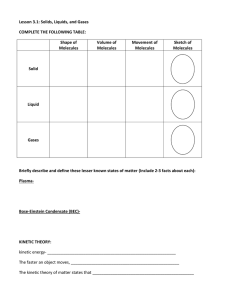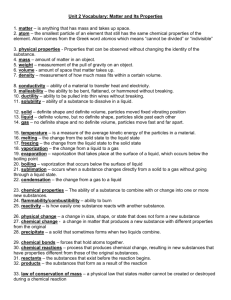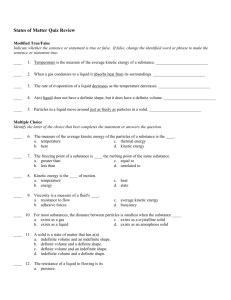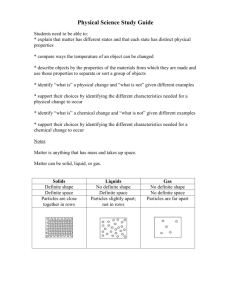20140916153797
advertisement
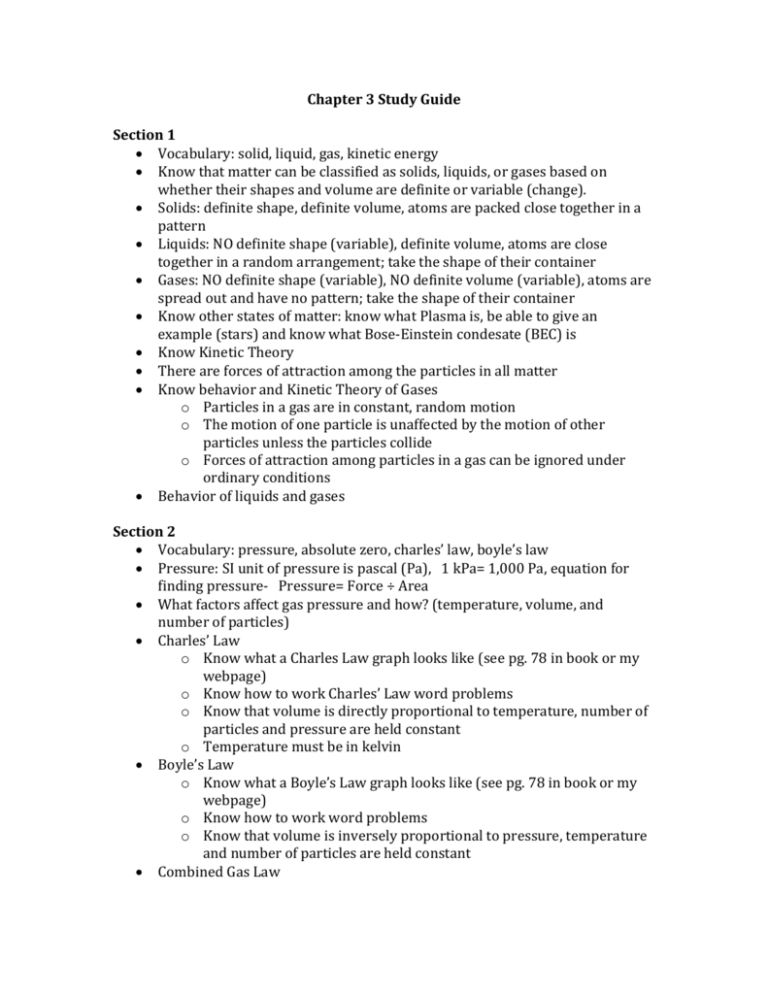
Chapter 3 Study Guide Section 1 Vocabulary: solid, liquid, gas, kinetic energy Know that matter can be classified as solids, liquids, or gases based on whether their shapes and volume are definite or variable (change). Solids: definite shape, definite volume, atoms are packed close together in a pattern Liquids: NO definite shape (variable), definite volume, atoms are close together in a random arrangement; take the shape of their container Gases: NO definite shape (variable), NO definite volume (variable), atoms are spread out and have no pattern; take the shape of their container Know other states of matter: know what Plasma is, be able to give an example (stars) and know what Bose-Einstein condesate (BEC) is Know Kinetic Theory There are forces of attraction among the particles in all matter Know behavior and Kinetic Theory of Gases o Particles in a gas are in constant, random motion o The motion of one particle is unaffected by the motion of other particles unless the particles collide o Forces of attraction among particles in a gas can be ignored under ordinary conditions Behavior of liquids and gases Section 2 Vocabulary: pressure, absolute zero, charles’ law, boyle’s law Pressure: SI unit of pressure is pascal (Pa), 1 kPa= 1,000 Pa, equation for finding pressure- Pressure= Force ÷ Area What factors affect gas pressure and how? (temperature, volume, and number of particles) Charles’ Law o Know what a Charles Law graph looks like (see pg. 78 in book or my webpage) o Know how to work Charles’ Law word problems o Know that volume is directly proportional to temperature, number of particles and pressure are held constant o Temperature must be in kelvin Boyle’s Law o Know what a Boyle’s Law graph looks like (see pg. 78 in book or my webpage) o Know how to work word problems o Know that volume is inversely proportional to pressure, temperature and number of particles are held constant Combined Gas Law o MEMORIZE THIS EQUATION (this one equation will help you work ANY of the gas law word problems) o Be able to work word problems o It is the relationship among temperature, volume, and pressure; number of particles is held constant Section 3 Vocabulary: phase change, endothermic, heat of fusion, exothermic, vaporization, heat of vaporization, evaporation, vapor pressure, condensation, sublimation, deposition Know phase change and the 6 common phase changes- make sure you know and can label the triangle diagram of the phase changes (see pg. 85, my powerpoint notes, or webpage for diagram) Know what temperature does during a phase change Know the types of energy changes: endothermic and exothermic (also know what heat of fusion is) Know what happens to the arrangement of molecules during ALL phase changes Know what happens to kinetic energy during/between ALL phase changes What is melting? What is freezing? What is boiling, condensation, sublimation, deposition, vaporization, evaporation, heat of vaporization (know if it is endo- or exo- thermic Check my webpage for extra practice on the math problems. Make sure if given a picture of molecules you could tell if it was a solid, liquid, or gas. (See pictures below) Be able to label the parts of a temperature curve. (See curves below. They are the same one is just already labeled.) (small vibrations) From A to B- solid, temperature is rising From B to C- melting point, temperature remains constant, phase change from solid to liquid From C to D- liquid, temperature is rising From D to E- boiling point, temperature remains constant, phase change from liquid to gas From E to F- gas, temperature is rising

